In the heart of lush forests and vibrant gardens, a tiny avian virtuoso reigns supreme, the Bulbul bird. With its distinctive crest and melodious warbles, this feathered songster captivates the imagination and stirs the soul.
From the crack of dawn till the fading hues of twilight, its sweet symphony fills the air, painting the day with serenity.
The Bulbul’s enchanting melodies, a fusion of trills and whistles, resonate through the dense canopy, creating a tapestry of sound that is both soothing and refreshing.
Its repertoire knows no bounds as it effortlessly weaves through intricate scales and playful motifs. But beyond its musical prowess, the Bulbul bird plays a vital role in its ecosystem, dispersing seeds and maintaining ecological balance.
With each flutter of its wings and every note it sings, the Bulbul bird reminds us of the harmonious relationship between nature and its inhabitants.
Key Identifying Characteristics of the Bulbul Bird
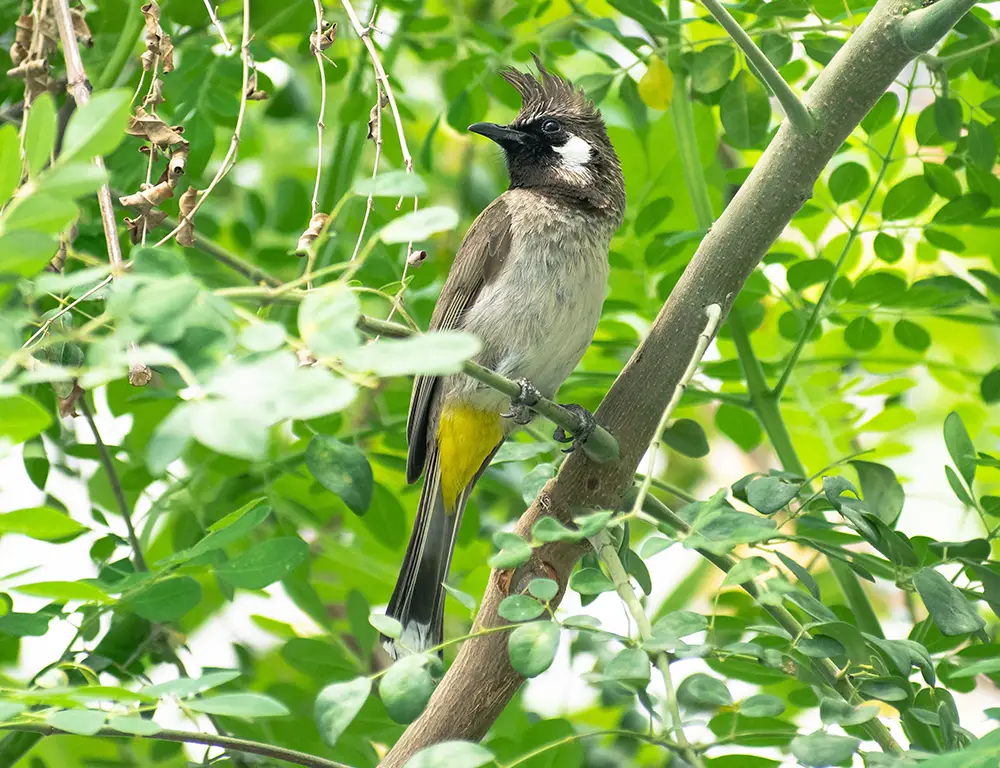
The Bulbul bird, belonging to the family Pycnonotidae, encompasses a diverse group of passerine birds known for their melodic songs, vibrant plumage, and distinctive features. Here are the key identifying characteristics of the Bulbul bird:
Size and Shape
Bulbuls typically range in size from 6 to 11 inches (15 to 28 cm) in length, with variations depending on the species. They have a compact and robust build, rounded wings, and a short, slightly curved bill suited for their omnivorous diet.
Plumage
Depending on the species and geographic region, bulbuls exhibit various plumage colors and patterns.
Standard colors include shades of brown, gray, olive, yellow, and black, often adorned with streaks, spots, or patches of contrasting hues. Some species feature distinctive crests or tufts on their heads, adding to their visual appeal.
Head Features
Many Bulbul species possess distinctively colored heads or facial markings, such as bold eye rings or patches of bare skin around the eyes.
Their heads may also sport tufts or crests, which can be erect or flattened depending on the bird’s mood or social interactions.
Voice and Song
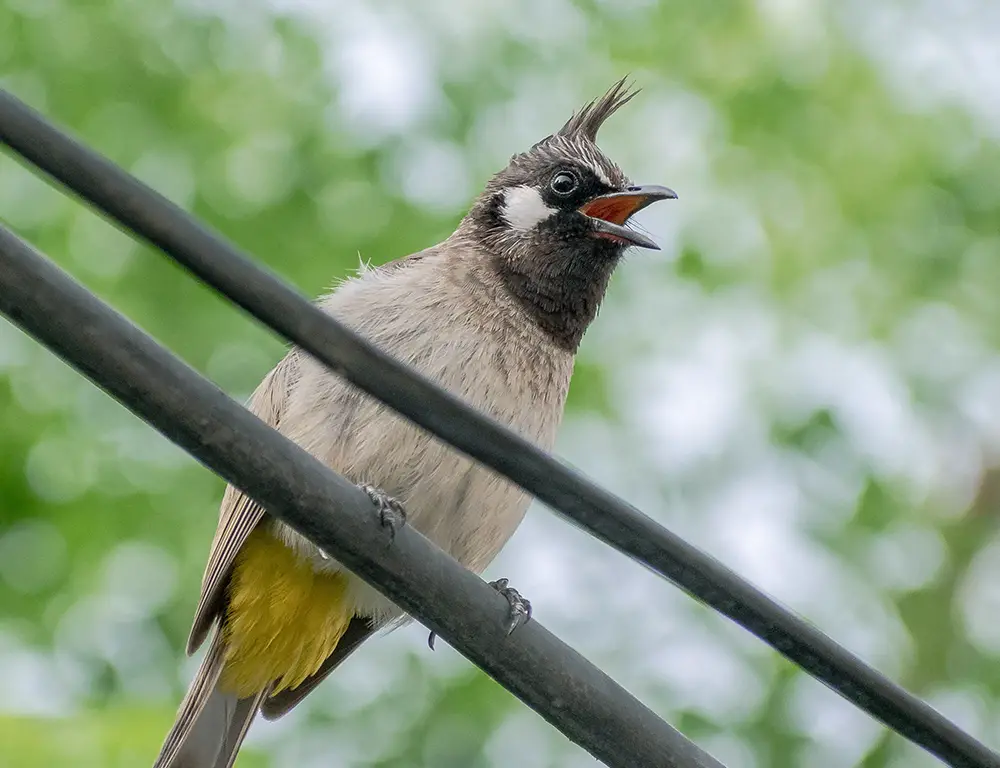
One of the most characteristic features of Bulbuls is their melodious vocalizations, which vary in complexity and tone among species.
Bulbuls are skilled mimics, often incorporating diverse sounds into their songs, including whistles, trills, chirps, and even mimicry of other bird species.
Their songs serve various purposes, including territory defense, courtship displays, and communication within social groups.
Behavior
Bulbuls are generally active and agile birds, frequently hopping and flitting among branches for food or mates.
They are highly social creatures, often forming small family groups or flocks, particularly outside the breeding season.
Bulbuls exhibit territorial behavior, defending their feeding and nesting areas through vocalizations and occasional aggressive encounters with intruders.
Habitat and Distribution
Bulbuls inhabit many habitats, including forests, woodlands, scrublands, gardens, and urban areas.
They are found across Africa, Asia, and parts of Europe, with different species occupying specific geographic regions and ecological niches.
Some species are highly adaptable to human-altered landscapes and can thrive in suburban gardens or parks.
Diet
Bulbuls are omnivorous birds with a diverse diet that includes fruits, berries, nectar, insects, and small invertebrates.
Their feeding habits play a crucial role in seed dispersal and pollination, contributing to the health and diversity of plant communities in their habitats.
Bulbuls are often observed foraging in trees and shrubs, probing flowers for nectar, gleaning insects from foliage, or scavenging fallen fruits on the forest floor.
Taxonomic Level and Life History of the Bulbul Bird
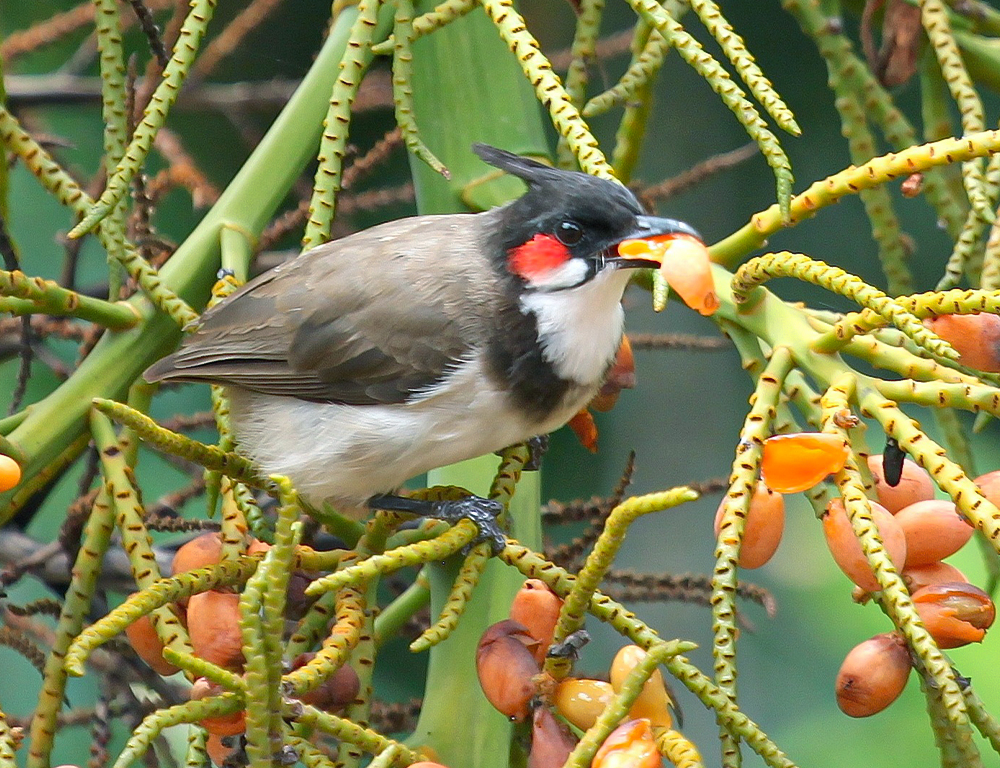
Dive into the world of the Bulbul bird and explore all the different aspects of its life:
Taxonomic Level and Classification
| Taxonomy Level | Classification |
| Kingdom | Animalia |
| Phylum | Chordata |
| Class | Aves |
| Order | Passeriformes |
| Family | Pycnonotidae |
| Genus | Pycnonotus |
| Species | Various species |
Range Map
The range map illustrates the distribution of Bulbul bird species across their natural habitats. It displays the geographic range where various species of bulbuls are found, including their breeding grounds, migration routes, and year-round ranges.
The map may include different colors or shading to represent the presence of bulbuls in specific regions and labels indicating species names or vital geographic features.
Food Habits
Bulbuls relish various fruits and berries, including figs, berries, and small fruits like mulberries and grapes. With their specialized brush-tipped tongues, bulbuls can extract nectar from flowers.
In addition to plant matter, bulbuls supplement their diet with protein-rich insects and small invertebrates.
Nesting Habit
| Nest Type | Description |
| Location | Situated in dense vegetation or shrubs |
| Egg Clutch Size | Varies depending on species |
| Incubation Period | About two weeks until hatching |
| Parental Care | Both parents participate in feeding and caring for the young |
Breeding
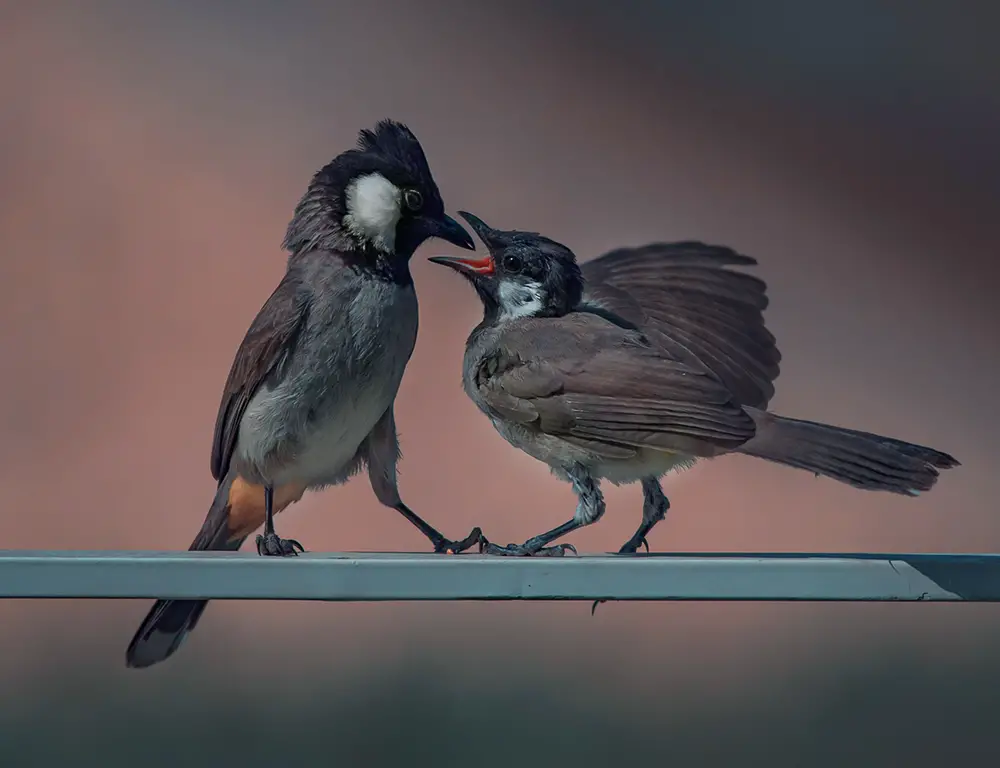
Bulbuls typically breed during the spring and summer months. Female bulbuls lay a clutch of eggs in their cup-shaped nests, which they incubate for about two weeks until hatching.
Both parents feed and care for the young chicks until they fledge and become independent.
Conservation Status
The conservation status of Bulbul bird species varies depending on the specific species and its geographic range.
While some species are widespread and abundant, others face threats such as habitat loss, deforestation, and illegal trapping for the pet trade.
Conservation efforts focused on habitat protection, restoration, and sustainable management are crucial for ensuring the long-term survival of Bulbul populations.
Diseases and Treatments
Bulbuls may be susceptible to various diseases, including avian influenza, avian pox, and parasitic infections.
Treatment options may include veterinary care, supportive therapy, and preventive measures such as vaccination and parasite control.
Proper hygiene, quarantine protocols, and monitoring of wild populations are essential for disease prevention and management.
10 Interesting Facts About the Bulbul Bird
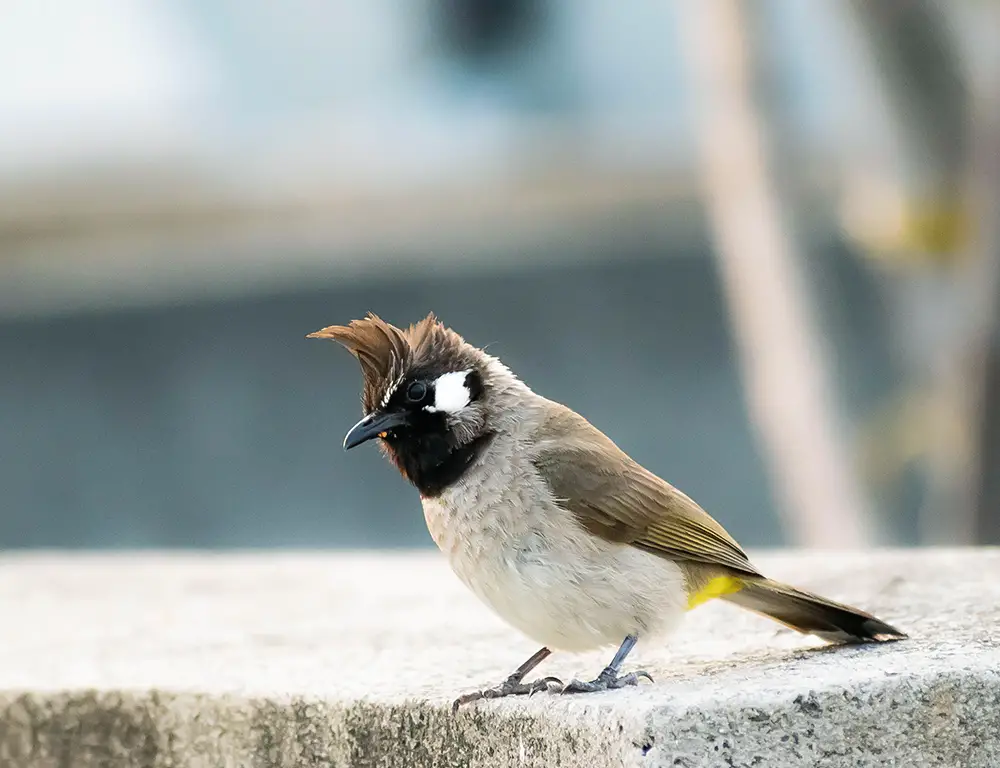
Bulbul birds are fascinating creatures with diverse species and unique behaviors. Here are 10 intriguing facts about these charming songsters:
1. Melodious Songs
Bulbuls are renowned for their musical vocalizations, which range from sweet whistles to complex warbles. Their songs fill the air with a symphony of sounds, making them delightful in gardens and woodlands.
2. Omnivorous Appetite
Bulbuls have diverse dietary preferences, feeding on fruits, berries, nectar, insects, and small invertebrates. Their omnivorous diet contributes to ecosystem dynamics by aiding in pollination and seed dispersal.
3. Colorful Plumage
Many Bulbul species boast vibrant plumage adorned with various colors and patterns. Their plumage adds color to their natural habitats, from striking yellows and oranges to subtle grays and browns.
4. Social Behavior
Bulbuls are highly social birds, often seen in small family groups or flocks outside of the breeding season. They engage in mutual grooming, territorial displays, and coordinated foraging activities, fostering social solid bonds within their communities.
5. Adaptability
Bulbuls are adaptable birds capable of thriving in diverse habitats, including forests, woodlands, scrublands, and urban areas.
Some species have successfully colonized human-altered landscapes, such as parks and gardens, demonstrating their ability to coexist with human activities.
6. Nest Building Skills
Bulbuls are skilled architects constructing cup-shaped nests using twigs, grasses, and other plant materials. These nests are typically placed in dense vegetation or shrubs, protecting their eggs and young chicks.
7. Parental Care
Both male and female bulbuls incubate the eggs and care for the young chicks. They diligently feed and protect their offspring, ensuring their survival until they are ready to fledge and become independent.
8. Mimicry Abilities
Some Bulbul species possess remarkable mimicry abilities, imitating the calls of other bird species and even human sounds. This mimicry adds depth and complexity to their vocal repertoire, enhancing their communication and social interactions.
9. Breeding Displays
During the breeding season, male bulbuls engage in elaborate courtship displays to attract mates. These displays may involve singing, dancing, and fluttering of wings, showcasing their vitality and fitness as potential partners.
10. Conservation Concerns
While many Bulbul species are widespread and abundant, others face threats such as habitat loss, deforestation, and illegal trapping for the pet trade.
Conservation efforts focused on habitat protection, restoration, and sustainable management are essential for safeguarding Bulbul populations and their ecosystems.
FAQs
What is the lifespan of a Bulbul bird?
Bulbul birds typically have a lifespan of 7 to 10 years in the wild. However, their lifespan can vary depending on habitat quality, predation pressure, and availability of food resources.
Are Bulbuls aggressive towards other birds?
Bulbuls can exhibit territorial behavior, especially during breeding, when they may become more aggressive towards intruders in their nesting territories.
However, their aggressiveness is usually directed towards other Bulbuls or smaller birds.
How do Bulbuls contribute to ecosystem health?
Bulbuls play a vital role in ecosystem dynamics by dispersing seeds of various plant species through their consumption of fruits and berries.
Additionally, their foraging activities help control insect populations, providing natural pest control services that benefit plants and crops.
Are Bulbuls kept as pets?
Yes, Bulbuls are sometimes kept as pets, particularly in regions where they are native.
However, it’s important to note that keeping wild birds as pets may not be legal in all areas, and captive-bred individuals are generally preferred over wild-caught ones to avoid impacting wild populations.
How can I attract Bulbuls to my garden?
To attract Bulbuls to your garden, you can provide suitable habitat features such as dense shrubs or trees for nesting and perching.
Planting various flowering plants that produce fruits and nectar will also attract Bulbuls, as they feed on both the flowers and the insects attracted to them.
Conclusion
In the enchanting realm of nature, the Bulbul bird stands as a testament to the beauty and harmony that abound in the wilderness.
Its melodious tunes echo through the verdant canopies as a gentle reminder of the interconnectedness of all living beings.
As guardians of biodiversity, Bulbuls play a crucial role in maintaining the delicate balance of their habitats, dispersing seeds, and contributing to the vitality of their ecosystems.
In our fast-paced world, the Bulbul bird offers a moment of respite—a symphony of serenity that transports us to tranquility and resilience.
Let us cherish and protect these avian maestros, ensuring that future generations can continue enraptured by their ethereal melodies.
For in the company of the Bulbul bird, we find solace, inspiration, and a profound connection to the natural world that sustains us all.